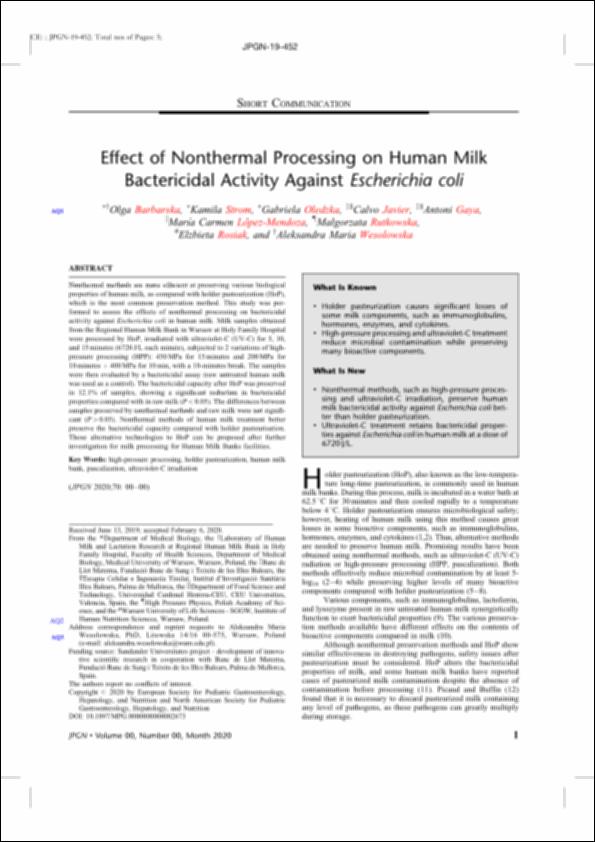Please use this identifier to cite or link to this item:
http://hdl.handle.net/10637/16281Effect of nonthermal processing on human milk bactericidal activity against "Escherichia coli"
| Title: | Effect of nonthermal processing on human milk bactericidal activity against "Escherichia coli" |
| Authors : | Barbarska, Olga Strom, Kamila Oledzka, Gabriela Calvo, Javier Gayà, Antoni López Mendoza, María Carmen Rutkowska, Malgorzata Rosiak, Elzbieta Wesolowska, Aleksandra Maria |
| Keywords: | Leche materna; Mother's milk; Lactancia materna; Breast feeding; Escherichia coli; Pasteurisation; Pasteurización |
| Publisher: | John Wiley & Sons |
| Citation: | Barbarska, O., Strom, K., Oledzka, G., Calvo, J., Gayà, A., López-Mendoza, M.C., Rutkowska, M., Rosiak, E., & Wesolowska, A.M. (2020). Effect of nonthermal processing on human milk bactericidal activity against "Escherichia coli". Journal of Pediatric Gastroenterology and Nutrition, 70(6), 864–867. https://doi.org/10.1097/MPG.0000000000002673 |
| Abstract: | Nonthermal methods are more efficient at preserving various biological properties of human milk, as compared with holder pasteurization (HoP), which is the most common preservation method. This study was performed to assess the effects of nonthermal processing on bactericidal activity against Escherichia coli in human milk. Milk samples obtained from the Regional Human Milk Bank in Warsaw at Holy Family Hospital were processed by HoP, irradiated with ultraviolet-C (UV-C) for 5, 10, and 15 minutes (6720 J/L each minute), subjected to 2 variations of high-pressure processing (HPP): 450 MPa for 15 minutes and 200 MPa for 10 minutes + 400 MPa for 10 min, with a 10-minutes break. The samples were then evaluated by a bactericidal assay (raw untreated human milk was used as a control). The bactericidal capacity after HoP was preserved in 12.1% of samples, showing a significant reduction in bactericidal properties compared with in raw milk (P < 0.05). The differences between samples preserved by nonthermal methods and raw milk were not significant (P > 0.05). Nonthermal methods of human milk treatment better preserve the bactericidal capacity compared with holder pasteurisation. Those alternative technologies to HoP can be proposed after further investigation for milk processing for Human Milk Banks facilities. |
| Description: | Este artículo es la versión postprint, siguiendo la política de acceso de la editorial John Wiley & Sons. Este es el post-print del siguiente artículo: Barbarska, O., Strom, K., Oledzka, G., Calvo, J., Gayà, A., López-Mendoza, M.C., Rutkowska, M., Rosiak, E., & Wesolowska, A.M. (2020). Effect of nonthermal processing on human milk bactericidal activity against "Escherichia coli". Journal of Pediatric Gastroenterology and Nutrition, 70(6), 864–867, que se ha publicado de forma definitiva en https://doi.org/10.1097/MPG.0000000000002673 This is the peer reviewed version of the following article: Barbarska, O., Strom, K., Oledzka, G., Calvo, J., Gayà, A., López-Mendoza, M.C., Rutkowska, M., Rosiak, E., & Wesolowska, A.M. (2020). Effect of nonthermal processing on human milk bactericidal activity against "Escherichia coli". Journal of Pediatric Gastroenterology and Nutrition, 70(6), 864–867, which has been published in final form at https://doi.org/10.1097/MPG.0000000000002673 |
| URI: | http://hdl.handle.net/10637/16281 |
| Rights : | http://creativecommons.org/licenses/by-nc-nd/4.0/deed.es |
| ISSN: | 0277-2116 1536-4801 (Electrónico) |
| Issue Date: | Jun-2020 |
| Center : | Universidad Cardenal Herrera-CEU |
| Appears in Collections: | Dpto. Producción y Sanidad Animal, Salud Pública Veterinaria y Ciencia y Tecnología de los Alimentos |
Items in DSpace are protected by copyright, with all rights reserved, unless otherwise indicated.


